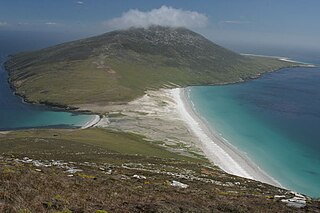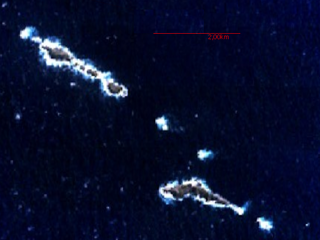
Lively Island is the largest of the Lively Island Group of the Falkland Islands, The island group lies east of East Falkland. Lively Island is the largest rat-free island in the Falklands, hence its importance to birdlife. The island also has a sheep farm.

Bleaker Island is one of the Falkland Islands, lying off south east Lafonia. The name is a corruption of "Breaker Island" due to the waves that break on it. It was also known as "Long Island" at one point.

Carcass Island is the largest of the West Point Island Group of the Falkland Islands.

Saunders Island is the fourth largest of the Falkland Islands, lying north west of West Falkland. The island is run as a sheep farm.
Keppel Island is one of the Falkland Islands, lying between Saunders and Pebble islands, and near Golding Island to the north of West Falkland on Keppel Sound. It has an area of 3,626 hectares and its highest point, Mt. Keppel, is 341 metres (1,119 ft) high. There is a wide, flat valley in the centre of the island with several freshwater lakes. The central valley rises steeply to the south-west, west and north. The north-east is low-lying, with a deeply indented coastline.

The Jason Islands are an archipelago in the Falkland Islands, lying to the far north-west of West Falkland. Three of the islands, Steeple Jason, Grand Jason and Clarke's Islet, are private nature reserves owned by the Wildlife Conservation Society of New York City. Other islands in the group are National Nature Reserves owned by the Falkland Islands Government.

Sea Lion Island is the largest of the Sea Lion Island Group of the Falkland Islands. It is 9 km2 (3 sq mi) in area. and lies 14 km (9 mi) southeast of Lafonia. It was designated a Ramsar site on 24 September 2001, and as an Important Bird Area. In 2017 the island was designated as a National Nature Reserve.

New Island is one of the Falkland Islands, lying north of Beaver Island. It is 238 km (148 mi) from Stanley and is 13 km (8.1 mi) long with an average width of 750 m (820 yd). The highest point is 226 metres (741 ft). The northern and eastern coasts have high cliffs but the eastern coasts are lower lying, with rocky shores and sandy bays. There are several smaller offshore islands in the group; North Island and Saddle Island have high cliffs but Ship Island and Cliff Knob Island are lower lying.

West Point Island is one of the Falkland Islands, lying in the north-west corner of the archipelago. It has an area of 1,469 hectares (5.67 sq mi) and boasts some of the most spectacular coastal scenery in the Falklands. The island is owned by Roddy & Lily Napier and run as a sheep farm and tourist attraction.

Beauchene Island is the southernmost of the Falkland Islands, lying about 54 kilometres (34 mi) south of Porpoise Point in Lafonia. It was discovered in 1701 by Jacques Gouin de Beauchêne, after whom it was named.

Poa flabellata, commonly known as tussac grass or just tussac, is a tussock grass native to southern South America, the Falkland Islands, South Georgia and other islands in the South Atlantic. There are also two isolated records from the herbarium at the French Muséum national d'histoire naturelle for the Île Amsterdam in the Indian Ocean.

Islas Ildefonso are a group of islands in Chile. The islands belong to the Commune of Cabo de Hornos in Antártica Chilena Province of Magallanes and Antártica Chilena Region. They lie 96 km (60 mi) west of Isla Hermite, part of Tierra del Fuego, and 93 km (58 mi) NNW of Diego Ramirez Islands, but only 27 km (17 mi) south of Isla Hoste or 23 km (14 mi) to rocks near Isla Hoste.

The striated caracara is a bird of prey of the family Falconidae. In the Falkland Islands, it is known as the Johnny rook, probably named after the Johnny penguin.

Grand Jason Island is a small island located at 51.05°S 61.05°W, east of the Steeple Jason Island. It is a part of the Jason Islands in the Falkland Islands, and along with Steeple Jason it is one of the "Islas los Salvajes" in Spanish.

Kidney Island so called due to its shape, is a small island with a land area of 33 hectares, to the east of East Falkland, not far from Stanley. It lies is at the east end of Berkeley Sound near Kidney Cove, and is separated from Port William by Menguera Point. It is a nature reserve and, unlike most of the main islands, is still covered in tussac grass. Its wildlife includes penguins and sea lions. It is one of only three places in the archipelago where king penguins breed; the others are Saunders Island and Volunteer Point on East Falkland.

Birdland Park and Gardens, often called Birdland, is a wildlife park in Bourton-on-the-Water, Gloucestershire, England. First opened in 1957, the park moved to its current site in 1989. Birdland began in the 5-acre (2.0 ha) grounds of a Tudor manor house called Chardwar and was started by Len Hill, who was often referred to as the Penguin Millionaire.

The wildlife of the Falkland Islands is quite similar to that of Patagonia. The Falkland Islands have no native reptiles or amphibians, and the only native land mammal, the warrah, is now extinct. However, a large number of bird species have been seen around the islands, and many of them breed on the smaller islands of the archipelago. Insects play a large role in the ecosystem of the islands, and over 200 species have been recorded. The waters around the Falkland Islands sustain many animals, including a large number of marine mammals. Three pinniped species breed on the islands.

Hope Harbour is an inlet at the north-west of West Falkland in the Falkland Islands of the South Atlantic Ocean. About 4 km long and 1.3 km wide, it is sheltered by the promontory of Grave Cove Camp in the south, a narrow ridge terminating in Hope Point to the north, Bramble Point Camp to the east, and West Point Island at its entrance to the west. Carcass Island lies 8 km north-east of Hope Point.
Seal Bay is a bay, about 1 km across, on the rugged and exposed north coast of East Falkland in the Falkland Islands of the South Atlantic Ocean. It lies some 40 km north-west of Stanley.
The Burdwood Bank, called Namuncurá in Argentina and other countries, is an undersea bank with a prominence of approximately 200 metres, part of the Scotia Arc projecting some 600 km (370 mi) from Cape Horn in the South Atlantic Ocean and located some 200 kilometres (120 mi) south of the Falkland Islands. Argentina claims economic rights over the whole of the bank, while the United Kingdom has designated about half of the bank as part of the Falklands Outer Economic Zone.
















